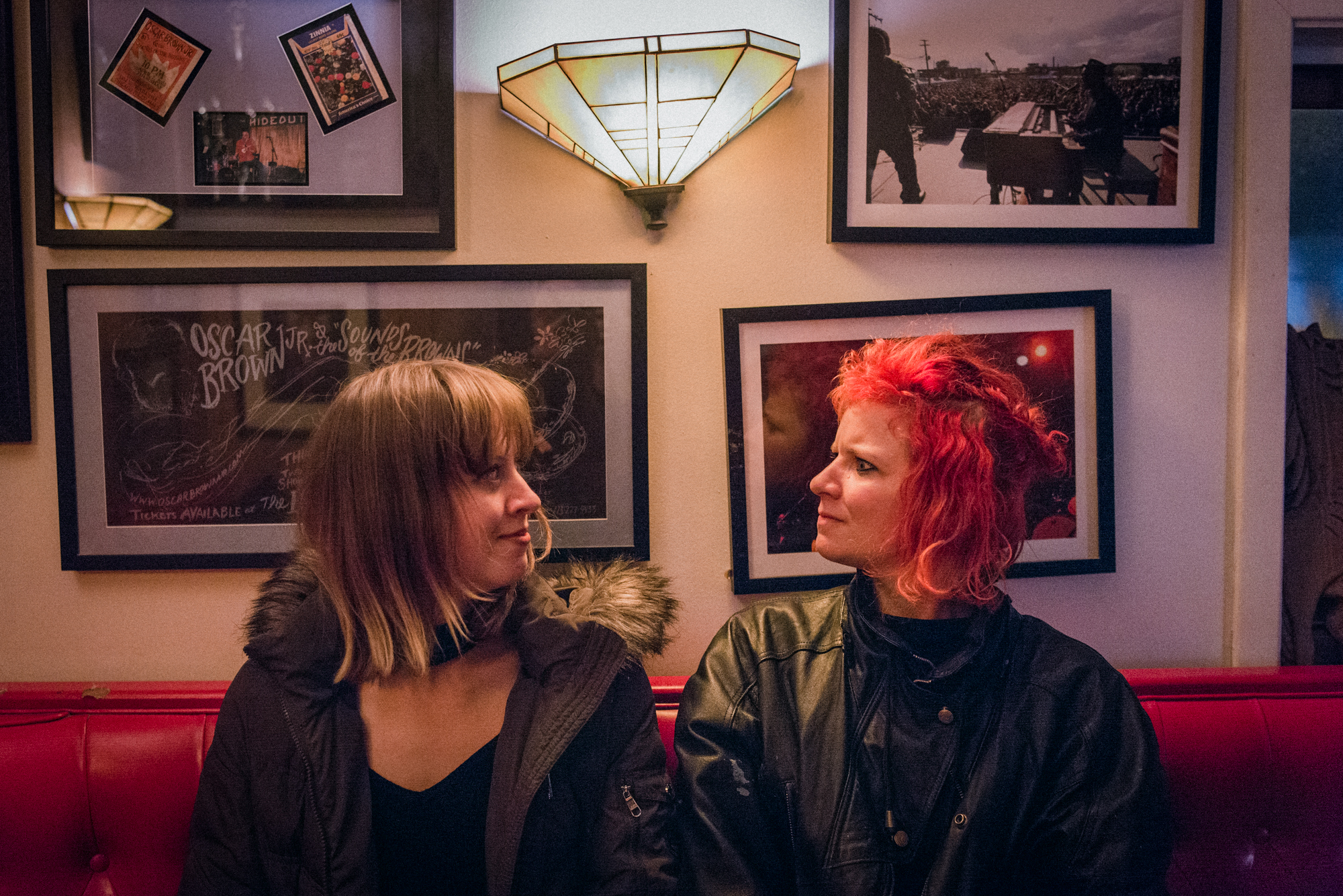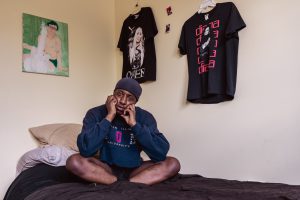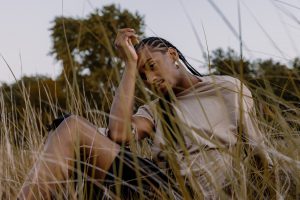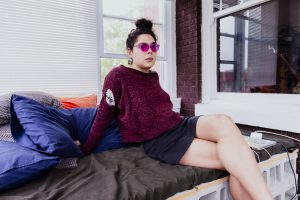To experience a live HOGG set is mesmerizing and terrifying. Over bass lines that pulsate, H and E* growl, howl, crawl, laugh, scream, and slam their bodies onto unsuspecting instruments. And then they stand still—so still, for so long. These movements are methodical and choreographed as they swap instruments that include bass, guitar, a floor tom, electronic samplers and drum machines. When I think of HOGG I think of my best friend. Around the time when we first saw HOGG play, we were also making music together, and we cared deeply about ecstatic, physical performances. It was moving then, and almost a relief, to see another pair of musicians dedicating their whole selves and bodies to that end.
HOGG has three studio records to date (“Solar Phallic Lion,” Scrapes, 2016; “Carnal Lust & Carnivorous Eating,” Rotted Tooth Recordings, 2016; “Bury the Dog Deeper,” Nihilist Records, 2015), with a fourth album set to be released this spring. Like the live performances, their lyrics evoke embodiment, horror, sensuality, and psychology. HOGG occasionally collaborates with other artists, such as the dancer Eryka Dellenbach and performance collective Antibody Corporation.
On the night that I met them for an interview, they had been invited to perform an improvised set alongside Michael Zerang and Jim Baker as part of this other, older experimental duo’s month-long residency at the Hideout. This meant HOGG wasn’t going to be undergoing their usual transformation that night. Before their set, we sat around a table on cherry red leather bench seats in the noisy greenroom of the Hideout and talked about the nature of experimental music and their rehearsal process. It became clear that the label “experimental” does more than signal HOGG’s divergence from musical conventions; it describes an exploratory rehearsal process that can be as brutally exhausting as their live sets.
*The members of HOGG requested that their full names not be printed.
Sasha Tycko: Do you want to start by talking about the show tonight and how you came to be part of the Jim Baker and Michael Zerang residency?
H: We did a performance piece with Eryka Dellenbach [who will dance with HOGG that night]—she’s a dancer, and we did this long 30-minute piece in February.
E: Yeah, February. At Links Hall. The event was called Peregrine Midwest. Jessica Cornish and Ambrosia Bartošekulva also performed as part of that.
H: Michael Zerang saw it, so he wanted to work with us after. But we didn’t realize it was an improv thing until a week ago [laughs]. We were going to play a set, and then we realized it was an improv thing. So it was kind of a surprise.
ST: Did you rehearse with them at all?
H: No.
ST: So this is your first time playing with them?
H: Yeah, I hadn’t even heard him play before. He sent us pictures of his instruments. We never do things like this. I think it’s cool though.
E: Yeah we don’t usually do improv stuff, but I think it sounds interesting.
ST: Do you have an idea of what you’re going to play?
E: We made a loose structure, but it’s just rhythmic stuff on sampler and drum machine.
H: Eryka’s dancing to it. We usually do really performative stuff, but that’s too weird. We’re usually really focused on performance and integrate that into what we’re doing, so it doesn’t make sense with the improvised thing. So we’re just doing the electronic parts.
ST: You don’t normally incorporate improvisation?
E: There’s intuitive stuff, but there’s usually a structure that we work within.
H: It’s kind of like controlled chaos. There’s usually a structure and it’s not completely rigid.
E: But it’s usually specific.
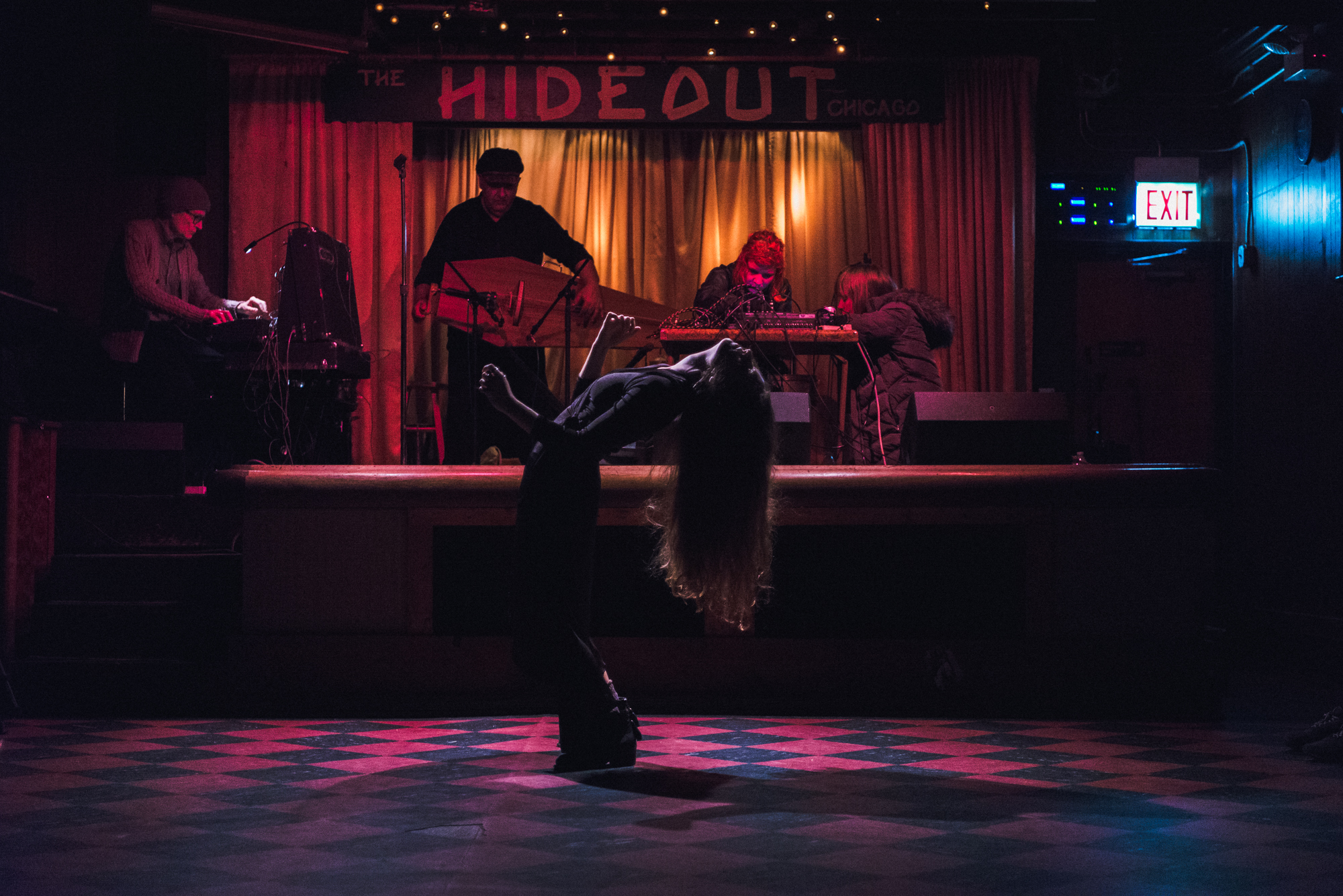
ST: The idea with this residency is to celebrate two people who have been making experimental music in Chicago together for 35 years. Do you draw on Chicago’s specific music history or see yourself in that lineage?
H: Well, I like some of the music that’s come out of here. I’m afraid of being here for 35 years; that kind of scares me. I like Ministry, Big Black, who else is from here? Chicago’s notoriously industrial because it’s a very dark and industrial city. So it makes sense that it has that lineage here. I guess I bounce off that a little. But that’s also why I’m scared of being here for twenty or 30 years. Because it’s a really harsh city. I’ve met a lot of older, jaded people.
ST: Where are you from originally?
H: Atlanta, Georgia. We’re both from there.
E: We met the summer before I moved to Chicago.
H: It was weird when we started playing music. She was in a punk band, and I started playing accordion with her while she played guitar.
E: Like, six years ago.
H: It was really weird. I’d give her accordion lessons and then we’d try to play music together, and I’d play accordion while she played guitar.
ST: How long were you doing that?
E: A couple months. Then she started playing bass and I was still playing guitar.
H: When she moved to Chicago I tried to learn bass. I’d never played bass before, and we just played guitar and bass together for three years. But we hated most everything that we wrote. We threw most of it away. It was like three years of writing a bunch of things and throwing them away, then writing a bunch of things, then throwing them away. I thought it was going to be like that forever.
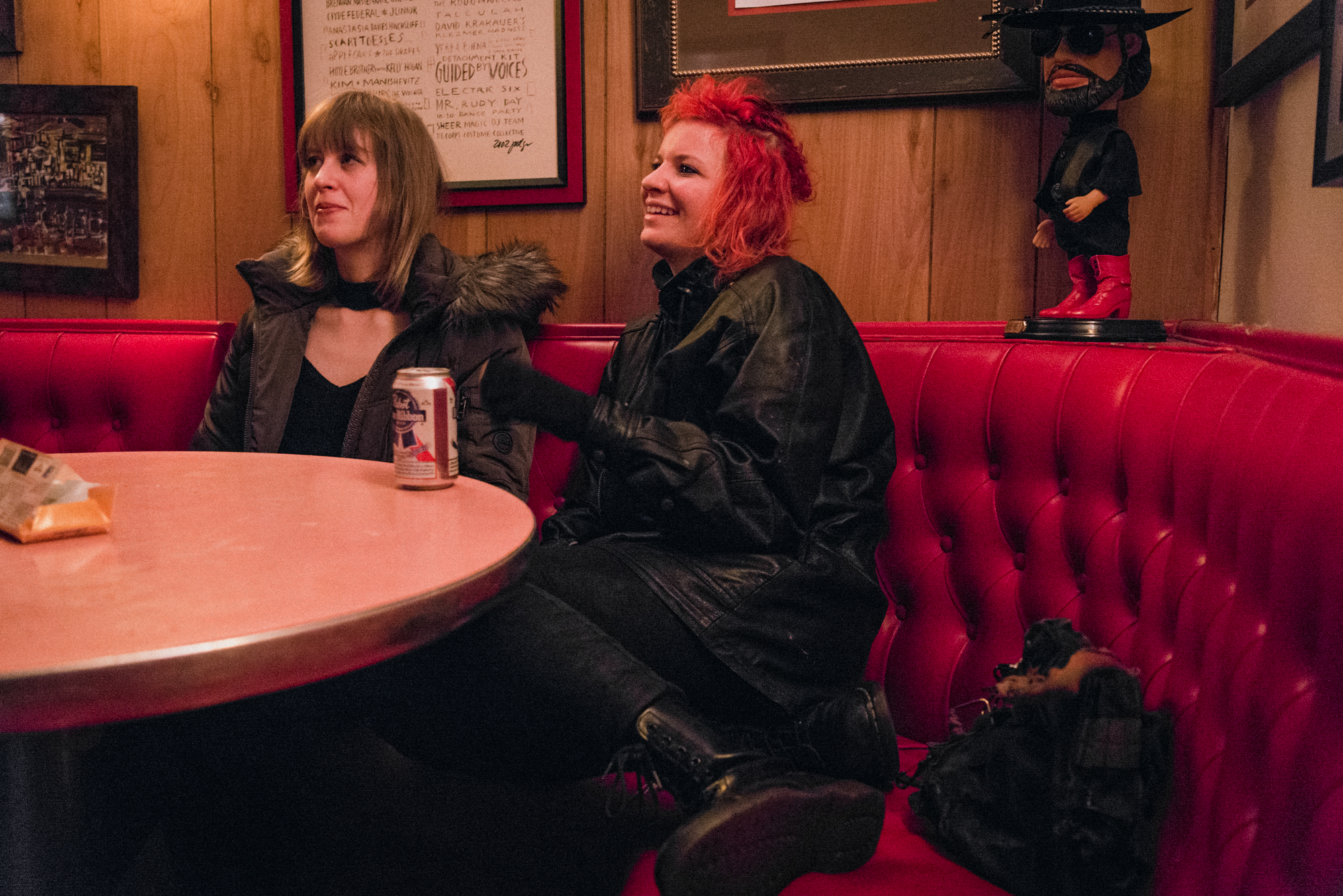
ST: At what point did you become HOGG or start to have the idea for HOGG?
H: I think after three years of throwing things away we finally figured out a direction we were happy with. I think what our problem was is that we listen to a lot of different types of music and we kept trying to play a certain kind of music, and we always thought it sounded derivative or cliché or not interesting enough. We started breaking it down and making it rhythmic and not musical. It’s hard to do, when you have a guitar and a bass, to make something nonmusical with two instruments that you usually make melodies with. I think we became very anti-melodic at a certain point, and that’s when we had more of a direction. We stopped being interested in composition. We were making songs before where it’d be like, this sounds like a good shoegaze song or something. And we were like, that’s not enough or that’s boring to make a good version of a genre that already exists. So we started breaking things down and started using sounds in a more functional way. We were just thinking about the words and how the sounds were functioning and how they’d affect people emotionally as opposed to making a good composition.
E: That was maybe three years ago, three and a half years ago, and we started playing shows.
ST: When you say you were breaking it down you mean breaking down the sounds?
E: We started using repetition a lot and it became a lot more minimal and raw. It’s different now.
H: It’s still minimal and raw now, but I feel like at first it was a lot more reminiscent of No Wave or something. And I think No Wave still has a connection to rock, and I think the elements of rock are now all gone.
ST: In your music?
H: Yeah.
ST: I’ve never really known what No Wave means.
H: It’s a very specific movement and era. It’s like New York—
E: In the ‘70s. There was a Chicago No Wave too.
H: Oh yeah. I mean ONO [Chicago gospel-noise band that was founded in 1980] is kind of No Wave.
E: It’s cool, it was like, experimental punk.
H: It was kind of like punk if they decided not use their instruments how they’re supposed to.
E: It would be very dissonant.
H: Yeah, so that’s how it was kind of No Wave, because the way we were using our instruments was minimalist. It’s sort of similar to what Michael [Zerang] does because he’s not playing the drums how you’re supposed to play the drums. He’s using it like a tool. So we were using the guitar as more of a tool than an instrument that you’re supposed to play. We’d just smash it with a piece of metal or something. We were using it more abstractly. We still do that, but that’s what made it sort of No Wave-y. All the instruments were used in a rhythmic way instead of a melodic or instrumental way.
ST: So even though you say you don’t try to write good compositions, you’re still writing some sort of structured piece that you return to multiple times. It’s not a song, exactly.
E: Well it sort of is, it’s just not melodic. And maybe the interest in it for us is not about oh, this is a cool part; this is a cool part. I feel like sometimes it’s more spatial.
H: It creates an environment.
E: Right, an environment. So there’ll be a more dense part and then a more spacious or minimal part. It’s more about that then like, a cool riff. But it’s still a composition that’s deliberate.
ST: How do you know when you’ve written something good, that you like?
E: It’s intuitive. We try a lot of stuff.
H: We’ve thrown a lot of stuff away. Even if we make something and we think it’s good we won’t keep it unless—I feel like we need to get a feeling of catharsis from it to keep it. But the process has gotten really insane. We write something and then we’ll play it for eight hours in a room until we completely lose our minds. And then from breaking down, like—
E: Mental barriers.
H: Yeah from mentally breaking ourselves down, that’s usually how we come up with something interesting.
ST: That sounds really intense. How often are you playing together?
H: Sometimes if we get really into a thing we’ll play several days in a row. But it’s usually just once or twice a week. But the time changes. Sometimes we’ll just work on stuff for an hour or two. But usually when we’re working on a piece that we’re trying to finish and we’re trying to come up with something we’ll be in the practice space for 6-8 hours.
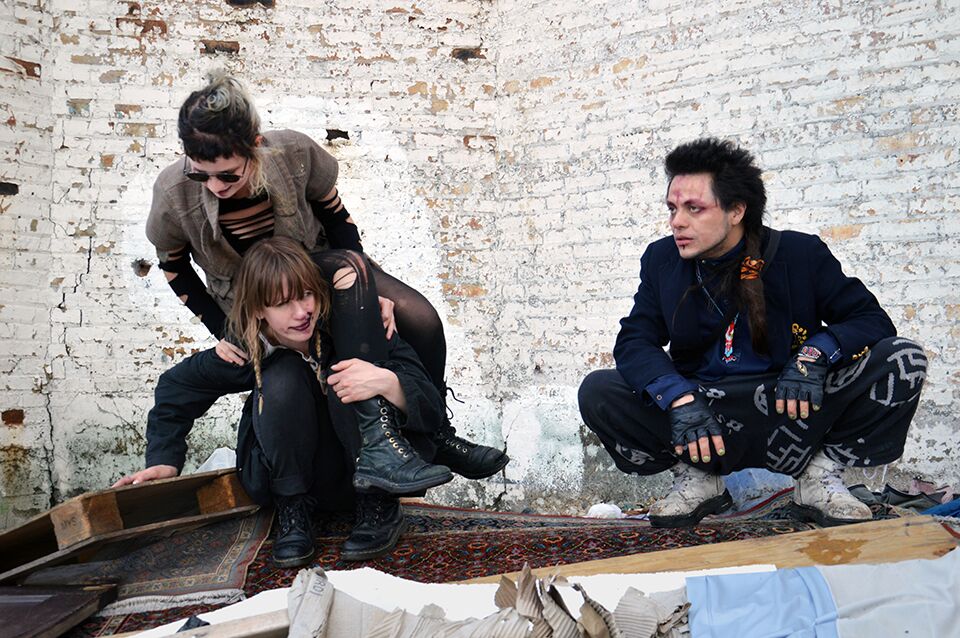
ST: Where do you draw the content from?
H: We don’t think about a predetermined idea.
E: But we have general interests that we’re exploring. Usually with the songs it’s not like, oh let’s make a song about this; it usually will start loose and then we’ll find it. Both of us are interested in themes of sexuality and violence, as well as socialization.
H: I think everything we do is a device. So everything we do, we don’t do for the composition. We do it for how it would affect someone who’s watching it.
E: We like making things that have contradictions in them or ambiguous emotions.
H: We’re more interested in making people think through affecting them emotionally. So a way to make people think though affecting them emotionally is to give them contradictory emotions or by creating a complex emotion. There’s a bunch of ways to do that. People are really affected by symbolism, so if you use contradictory symbolism and they’re highly emotional it really affects people. For example, we’ll have parts where [E] will start laughing. We don’t like to have anything excessive, because we think those things are more potent when they’re stripped down.
ST: In your typical sets you always bring in a lot of theatrical and performative elements. How do you incorporate those elements into your songwriting?
E: The performative elements, when we first started, were separate from the songs, so it’d be like an interruption. Like, we’d play a couple songs and then we’d have a part where [H] lit off fireworks. We did this one where [H] was lighting fireworks and I had stuff burning on my face—
H: Your eyebrows were on fire.
E: Yeah, my eyebrows were on fire. [Both laugh]. We did one with balloons—it was just, like, absurdist gestures. It’s less absurd now–
H: It was kind of wacky before. I think it’s absurd but not wacky now.
E: Yeah, now it’s more integrated in the songs. We now more embody these characters that we’re channeling while we’re performing. So they’re more connected to the sound and the vocals; it’s very vocally driven and emotionally driven. Whereas before it was these more interruptive gestures.
H: We kind of created these personas or characters when we were performing, and it was a way of separating our profane selves from our performative selves. It helped us get into a head space that made us forget about our profane lives.
E: I think it’s a more powerful headspace, where you can emote more.
H: It’s a similar thing that happens in a lot of rituals. For example, if people are wanting to embody a certain characteristic or to gain a certain characteristic, they will dress up as a goddess who represents that characteristic and surround themselves with the things that remind them of the characteristic and they will fully forget themselves, and that’s a way of losing themselves and gaining this thing from the ritual. I feel like it’s kind of ritualistic in that way. It’s important for us to lose ourselves in the performances.
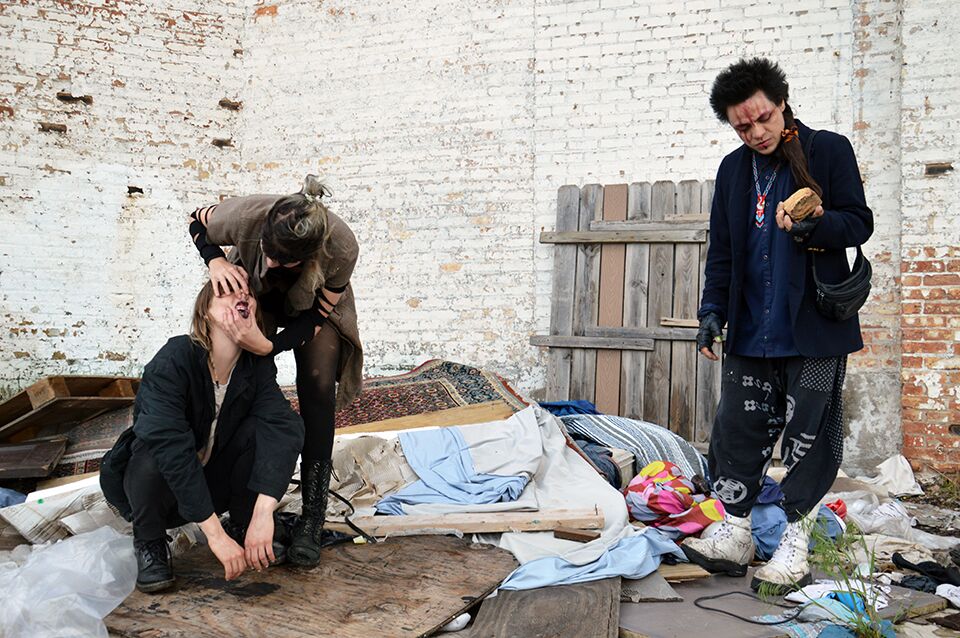
ST: What are you working on right now?
H: We recorded an album—
E: In July. And it just got finished being mastered. I think it will come out in the spring. Now we’re just working on new material. We’re kind of going to go back into hiding. I guess in the nature of breaking it down, once we’ve made a body of work we like, we burn it down and try to find something new—new inspiration, new ways of working.
H: We can never get comfortable because it gets boring.
E: We’re in that phase right now.
ST: How do you find inspiration?
H: We have to experiment and fail.
E: We do a lot of that, but we also both have a lot of research that we’re always doing and that ends up getting integrated into the work.
ST: What kinds of subjects are you looking into?
E: In the last body of work we were looking at a lot of ritual.
H: I was really into Nietzsche in the last bit. I think that contributed to the characters because I was thinking about the banality of evil a lot. So we have individual practices where we’re thinking a lot. [E] also writes a lot and I make beats a lot, and then we gather samples. We also mess around together at the practice space. But that’s what’s been really crazy. Since we’ve been trying to change things it’s less natural now. We’ll have practices that are six hours long, and we don’t find anything that works. We kind of lose our minds there. My body will hurt for 24 hours, because we’ll be doing weird physical things. We won’t eat. Last time I was doing something where I was just falling on my face over and over again. [Laughs]. We keep being like, oh, we can try this thing, and it will be something that’s really physically exhausting and then it won’t even work.
E: I think it’s starting to get somewhere though.
H: It’s painful.
E: It is painful. But it’s rewarding.
H: That was happening for a few months. And it makes you feel sad and it makes your body hurt. But I think it’s what needs to happen. It’s really scary when you are trying to start over because you have that phase and it feels like you’re not going to move forward.
ST: But it’s starting to turn into something?
E: I think so.
Featured photo: E and H of HOGG face each other in the greenroom of the Hideout. Behind them is a wall of photographs of musicians. Photo by Ryan Thiel.
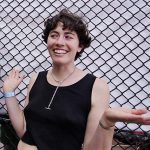 Starting from the proposition that art-making is world-making, Sasha Tycko combines community organizing and curatorial work with writing, music, and performance. Tycko is a founding editor of The Sick Muse zine and an administrator of the F12 Network, a DIY collective that addresses sexual violence in arts communities. Find more on IG: @t_cko and at www.nomoneynoborders.com. Photo by Julia Dratel.
Starting from the proposition that art-making is world-making, Sasha Tycko combines community organizing and curatorial work with writing, music, and performance. Tycko is a founding editor of The Sick Muse zine and an administrator of the F12 Network, a DIY collective that addresses sexual violence in arts communities. Find more on IG: @t_cko and at www.nomoneynoborders.com. Photo by Julia Dratel.
